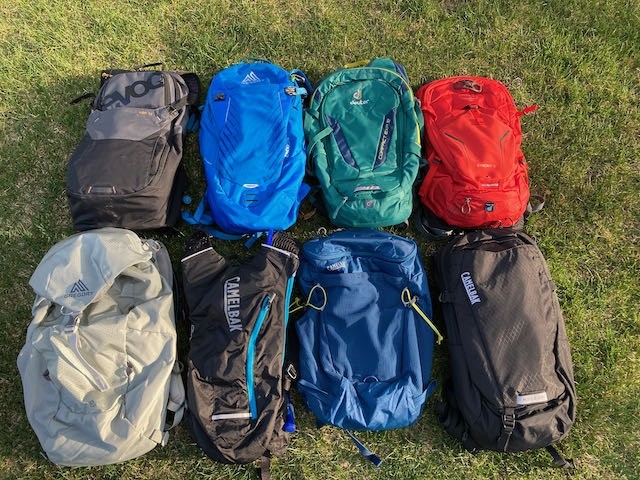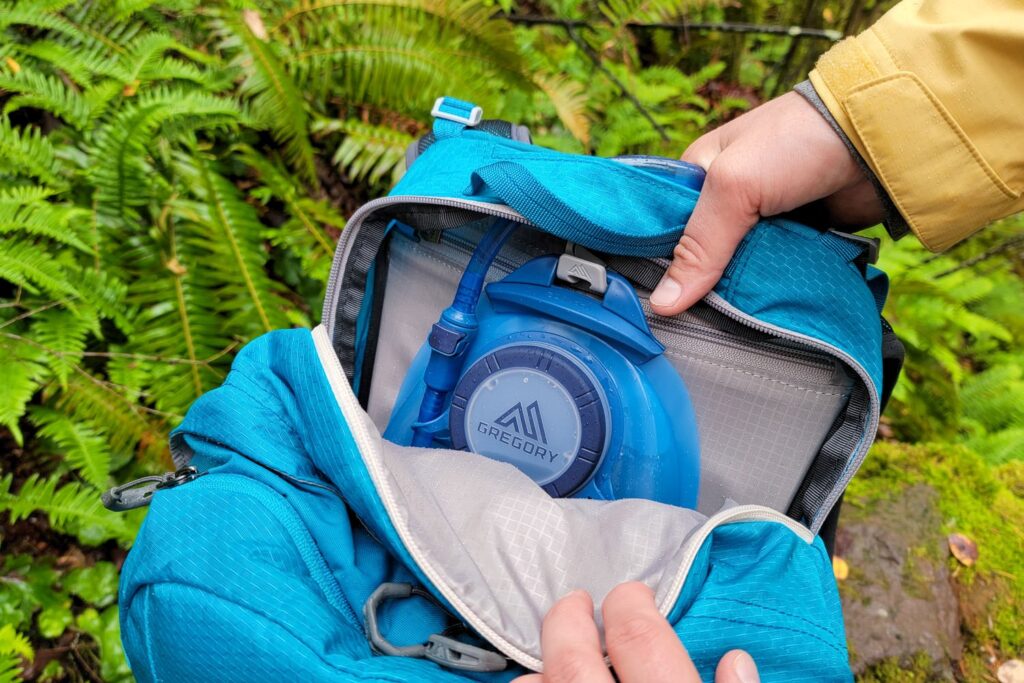
When searching for the perfect backpack to carry your hydration system, it’s essential to consider a few key features. The right backpack can make all the difference in keeping you comfortable and hydrated during your outdoor adventures. From the size and capacity to the durability and functionality, this article will explore the top tips for choosing a backpack that is compatible with your hydration system. So whether you’re planning a hike, a bike ride, or any other active pursuit, read on to discover how to find the ideal backpack for all your hydration needs.

This image is property of u7q2x7c9.stackpathcdn.com.
Size and Capacity
Consider the backpack size
When choosing a backpack with hydration system compatibility, it is essential to consider the size of the backpack itself. This will depend on your specific needs and the activities you will be participating in. If you are planning shorter trips or day hikes, a smaller backpack with a capacity of around 10-20 liters may be sufficient. However, for longer adventures or multi-day hikes, you may need a larger backpack with a capacity of 40 liters or more to accommodate all your gear and supplies.
Check the capacity for the hydration system
In addition to the overall size of the backpack, it is important to check the capacity specifically dedicated to the hydration system. Most backpacks will state the maximum size of the hydration bladder they can accommodate. It is recommended to choose a backpack with a capacity that matches your intended use. For example, if you plan on being out for long periods without access to water, a larger hydration bladder may be necessary to ensure you stay hydrated.
Evaluate the backpack’s overall storage capacity
Along with the size and capacity dedicated to the hydration system, it is crucial to evaluate the backpack’s overall storage capacity. Consider the number of compartments, pockets, and attachment points available for organizing your gear and other essentials. A backpack with multiple compartments can help you stay organized and easily access your belongings. Additionally, check if the backpack offers external attachment points or straps for carrying extra gear such as trekking poles or a sleeping bag.
Hydration System Compatibility
Ensure the backpack is compatible with a hydration system
Before purchasing a backpack, it is vital to ensure that it is specifically designed with hydration system compatibility in mind. Some backpacks may come with built-in hydration compartments or sleeves to hold the hydration bladder securely in place. Others may have specially designed pockets or loops to accommodate the hydration system components. It is important to verify this compatibility to ensure a hassle-free experience when using the hydration system with the backpack.
Check if it has a dedicated hydration compartment
A dedicated hydration compartment can be a convenient feature in a backpack. This compartment is designed to hold the hydration bladder securely and often includes a separate tube outlet for easy access. Having a dedicated compartment ensures that the hydration system remains upright, reducing the chances of leakage or spillage. It also helps in efficient packing and organization of your other items in the backpack.
Verify the compatibility with different hydration bladder brands
Different hydration bladder brands may have slightly different designs and dimensions. It is crucial to check if the backpack you are considering is compatible with a variety of hydration bladder brands. This flexibility ensures that you have options when it comes to choosing a hydration bladder that fits your personal preference or is readily available in the market. Compatibility with multiple brands also allows for easier replacement or upgrading of hydration bladders in the future.

This image is property of u7q2x7c9.stackpathcdn.com.
Easy Access to Hydration
Look for a convenient hydration tube outlet
A well-designed backpack with hydration system compatibility will have a convenient hydration tube outlet. This outlet allows you to easily access the hydration tube while wearing the backpack. Look for a backpack that has the outlet positioned in a place that is easily accessible, such as near the shoulder strap. This ensures that you can stay hydrated without having to fumble with the backpack or interrupt your activities.
Check if it has a hands-free hydration system
Hands-free hydration systems are incredibly convenient, especially during high-intensity activities or when you need to keep your hands free for other tasks. Look for a backpack that offers a hands-free hydration system. This typically involves a tube clip or magnet on the shoulder strap that allows you to secure the hydration tube in place and easily access it without needing to use your hands.
Consider the ease of refilling the hydration bladder
Refilling the hydration bladder can be a frequent occurrence, particularly during longer outings. Consider how easy it is to refill the hydration bladder without removing it from the backpack. Some backpacks feature a dedicated hydration compartment with a side zipper or external access point, allowing you to refill the bladder without the need to unpack the entire backpack. This feature can be a significant time and convenience saver.
Comfort and Fit
Evaluate the backpack’s padding and ergonomic design
Comfort is a crucial aspect when choosing a backpack. Look for a backpack that offers ample padding in the back panel and shoulder straps. These areas often bear the brunt of the weight, so proper padding ensures comfort and reduces strain on your body. Additionally, consider the ergonomic design of the backpack, as it determines how well the backpack contours to your body and improves overall weight distribution.
Consider the adjustability of the shoulder straps and waist belt
To achieve a comfortable fit, it is important to have adjustable shoulder straps and a waist belt. This allows you to customize the fit of the backpack to your body shape and size, ensuring optimal weight distribution. Adjustable straps and belts also enable you to tighten or loosen them during different activities or as the load in the backpack changes. Look for backpacks with easily adjustable straps and belts for maximum comfort.
Check for ventilation features to prevent excessive sweating
When wearing a backpack for an extended period, especially during physical activities, it is common to experience excessive sweating. Look for backpacks that incorporate ventilation features to minimize this issue. Mesh panels on the back panel or shoulder straps allow for air circulation, reducing the build-up of moisture and heat. Proper ventilation can greatly enhance overall comfort, particularly when undertaking strenuous activities.

This image is property of images.singletracks.com.
Durability
Look for a backpack made of durable material
Durability is essential, especially if you plan on using the backpack for outdoor activities or in rugged environments. Look for backpacks made of durable materials such as nylon or polyester. These materials are known for their resistance to wear and tear and can withstand the rigors of outdoor adventures. Additionally, consider backpacks with reinforced areas or panels that are prone to heavy use, such as the bottom or high-stress points.
Check the quality of zippers, buckles, and straps
The longevity of a backpack depends not only on the material but also on the quality of its components. Check the quality of zippers, buckles, and straps before making a purchase. Look for heavy-duty zippers that glide smoothly without jamming or breaking. Sturdy buckles that securely hold the straps in place are also important for durability. Additionally, ensure that the straps are well stitched and reinforced to handle the weight and demands of outdoor activities.
Consider additional features like reinforced stitching or abrasion resistance
Some backpacks come with additional features that enhance their durability. Look for backpacks with reinforced stitching in critical areas to prevent tearing or fraying over time. Abrasion resistance is also an important feature, particularly if you plan on using the backpack in rugged environments where it may come into contact with rough surfaces. These additional features can significantly extend the lifespan of your backpack.
Weight
Consider the overall weight of the backpack
The weight of the backpack itself is an important factor, particularly if you are aiming for a lightweight and comfortable carrying experience. Consider your intended use and the activities you will be participating in. If you plan on fast-paced activities such as trail running or cycling, a lightweight backpack is crucial for mobility and reducing fatigue. However, if you are planning longer trips or backpacking adventures, you may need to balance weight with the necessary carrying capacity.
Check if the backpack has a lightweight design
When selecting a backpack, look for models with a lightweight design. This typically involves using lightweight materials and streamlined construction techniques to reduce unnecessary bulk. Lightweight backpacks are often more comfortable to carry, particularly during longer or physically demanding activities. They also allow you to carry more gear without adding excessive weight to your load.
Evaluate the weight distribution for comfortable carrying
Even with a lightweight backpack, the weight distribution plays a significant role in overall comfort. Look for backpacks that distribute the weight evenly across your shoulders, back, and hips. This helps to minimize strain on any one area and allows for a more balanced and comfortable carrying experience. Proper weight distribution can prevent discomfort or pain, particularly during extended periods of wear.

This image is property of images.squarespace-cdn.com.
Additional Storage Features
Consider the availability of extra pockets and compartments
A backpack with additional pockets and compartments can greatly enhance organization and accessibility. Look for backpacks with multiple zippered pockets, mesh pockets, or stretch pockets. These additional storage options allow you to easily separate and access your gear, snacks, or smaller items without having to dig through the main compartment. Consider your specific needs and preferences in terms of organization when evaluating the availability of extra pockets and compartments.
Check for attachment points or straps for gear
If you plan on carrying additional gear or equipment, it is important to check the availability of attachment points or straps on the backpack. Look for backpacks with external attachment points, bungee cords, or gear loops. These features allow you to secure items such as trekking poles, ice axes, or tent poles externally, freeing up space inside the backpack for other necessities. External attachment options can be particularly useful for activities that require quick access to specific gear.
Evaluate the accessibility and organization of the backpack
Ease of access and organization is key when using a backpack for outdoor activities. Evaluate how easy it is to access the main compartment, as well as any additional pockets or compartments. Look for backpacks with a wide opening or multiple access points for convenient packing and retrieval of your belongings. Additionally, consider if the backpack offers any internal organization features such as dividers or internal pockets to further enhance the accessibility and organization of your gear.
Water Resistance
Check if the backpack has water-resistant or waterproof features
A water-resistant or waterproof backpack is particularly important if you plan on using it in wet or rainy conditions. Look for backpacks that offer water-resistant or waterproof materials on the exterior. This will help protect your gear from moisture and keep it dry. Keep in mind that while a water-resistant backpack can withstand light rain, a truly waterproof backpack will provide higher levels of protection, even in heavy downpours or submersion.
Consider the material’s ability to repel water
In addition to the overall water resistance, consider the material’s ability to repel water. Some backpacks come with specialized coatings or treatments that enhance the water-repellent properties of the fabric. These treatments allow water to bead and roll off the surface of the backpack, reducing the risk of moisture seeping through the material. This can be particularly beneficial in wet environments or if you anticipate encountering water during your outdoor activities.
Evaluate the effectiveness of built-in rain covers
Many backpacks come with built-in rain covers as an added layer of protection against moisture. These rain covers are typically stored in a designated pocket or compartment and can be easily deployed to cover the entire backpack in case of rain. Evaluate the effectiveness of the rain cover in keeping your gear dry. Look for backpacks that feature high-quality rain covers with secure fasteners and good coverage to ensure your belongings remain protected during wet conditions.

This image is property of cdn.thewirecutter.com.
Brand and Price
Consider reputable backpack brands known for quality
When investing in a backpack, it is beneficial to consider reputable brands known for their quality and durability. Established brands often have a proven track record of manufacturing reliable and well-designed backpacks. They usually use high-quality materials and focus on providing ergonomic and functional features. Research and explore backpack brands that have a positive reputation among outdoor enthusiasts to ensure you are purchasing a reliable product.
Evaluate customer reviews and ratings
Checking customer reviews and ratings can provide valuable insights into the overall quality and performance of a backpack. Take the time to read reviews and evaluate the experiences and opinions of other users. Look for consistent positive feedback about the backpack’s durability, comfort, and usability. However, keep in mind that personal preferences and expectations may differ, so consider multiple perspectives when making a decision.
Find a backpack that fits your budget and offers value for the price
Price is an important consideration when choosing a backpack. Set a budget based on your financial means and set out to find a backpack that offers value for the price. Consider the features and quality offered by each backpack within your budget range. It is essential to strike a balance between cost and quality, ensuring that the backpack meets your needs and expectations, while still being affordable and within your means.
Try Before Buying
Visit a local store to try on different backpacks
While online research can provide valuable information, it is highly recommended to visit a local store to physically try on different backpacks. This allows you to assess the fit, comfort, and overall feel of the backpack on your body. Pay attention to how the backpack sits on your shoulders and hips, as well as any pressure points or potential discomfort. Trying on different backpacks will help you find the one that feels the most comfortable and well-suited to your body type.
Check if the backpack feels comfortable for your body type
Each person’s body type is unique, and what feels comfortable for one person may not be the same for another. Consider your height, torso length, and body shape when evaluating the comfort of the backpack. Adjustable straps and belts mentioned earlier can help tailor the fit to your body type. It is important to find a backpack that feels comfortable and supportive, as discomfort or strain can lead to a less enjoyable outdoor experience.
Ensure the backpack suits your specific needs and preferences
Finally, ensure that the backpack suits your specific needs and preferences. Consider the activities you will be participating in and the type of gear and supplies you need to carry. Take note of any personal preferences such as the number of pockets, the design, or the color. Everyone has different requirements when it comes to backpacks, so find one that aligns with your specific needs and allows you to embark on your outdoor adventures with confidence.
By keeping these tips in mind and thoroughly considering each section, you can make an informed decision when choosing a backpack with hydration system compatibility. Remember, finding the right backpack is a personal choice, and it is essential to select one that fits well, suits your needs, and provides the comfort and convenience you desire for your outdoor pursuits. With the right backpack, you can confidently stay hydrated and enjoy your outdoor adventures to the fullest.





